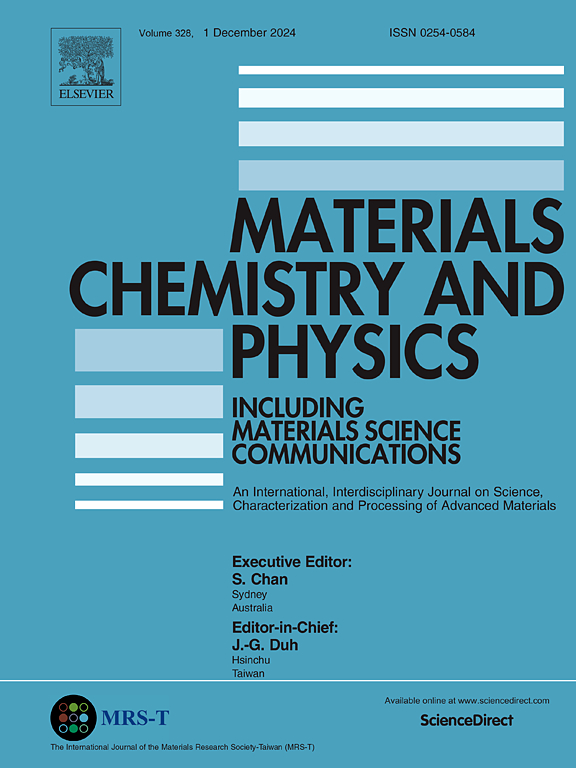IF 4.3
3区 材料科学
Q2 MATERIALS SCIENCE, MULTIDISCIPLINARY
引用次数: 0
摘要
针对化学沉淀法制备的氧化铟团聚严重、分散性差的问题,本研究探讨了在 NH4Ac-HCl 缓冲溶液体系中合成 In2O3 的方法。采用 SEM、XRD 和其他表征技术研究了缓冲溶液 pH 值和进料方法对氧化铟粉末形貌和粒度的影响,并对其物理和化学性质进行了表征。结果表明,在反应溶液中引入 NH4Ac-HCl 缓冲体系可有效抑制晶核形成,促进晶核生长,从而减少颗粒团聚。通过将缓冲体系的 pH 值保持在 3.5-4.5 的狭窄范围内,我们合成了平均直径为 60 nm 的球形氧化铟粒子。这些颗粒具有很高的结晶度,而且没有团聚现象。此外,缓冲体系改变了 In2O3 的光学特性,使其直接带隙从 3.20 eV 缩小到 2.95 eV。值得注意的是,在 pH 值为 4.5 的条件下合成的 In2O3 显示出的光致发光(PL)发射峰强度最低,这表明晶体的完整性更高,缺陷发生率更低。光催化降解研究进一步验证了我们的发现。在 pH 值为 4.5 的缓冲体系中,氧化铟对亚甲蓝 (MB) 的降解率为 55 ± 1%,明显低于对照体系中 93 ± 1% 的降解率。本文章由计算机程序翻译,如有差异,请以英文原文为准。
Controllable synthesis and characterization of In2O3 nanopowder in the NH4Ac-HCl buffer system
In response to the severe agglomeration and poor dispersibility of indium oxide prepared by the chemical precipitation method, this study investigates the synthesis of In2O3 within the NH4Ac-HCl buffer solution system. SEM, XRD, and other characterization techniques were employed to study the effects of buffer solution pH and feeding method on the morphology and particle size of the indium oxide powder, as well as to characterize their physical and chemical properties. The results indicated that the introduction of the NH4Ac-HCl buffer system into the reaction solution effectively inhibits nucleation and promotes the growth of crystal nuclei, thereby reducing particle agglomeration. By maintaining the buffer system's pH within a narrow range of 3.5–4.5, we achieved the synthesis of spherical indium oxide particles with an average diameter of 60 nm. These particles demonstrate high crystallinity and are devoid of agglomeration. Moreover, the buffer system alters the optical characteristics of In2O3, narrowing its direct band gap from 3.20 eV to 2.95 eV. Notably, In2O3 synthesized at a pH of 4.5 exhibits the lowest intensity of photoluminescence (PL) emission peaks, suggesting a higher level of crystalline integrity and a lower incidence of defects. Photocatalytic degradation studies provide further validation of our findings. At a pH of 4.5 within the buffer system, the degradation rate of indium oxide for methylene blue (MB) is measured to be 55 ± 1 %, which is significantly lower than the degradation rate of 93 ± 1 % observed in the control system.
求助全文
通过发布文献求助,成功后即可免费获取论文全文。
去求助
来源期刊

Materials Chemistry and Physics
工程技术-材料科学:综合
CiteScore
8.70
自引率
4.30%
发文量
1515
审稿时长
69 days
期刊介绍:
Materials Chemistry and Physics is devoted to short communications, full-length research papers and feature articles on interrelationships among structure, properties, processing and performance of materials. The Editors welcome manuscripts on thin films, surface and interface science, materials degradation and reliability, metallurgy, semiconductors and optoelectronic materials, fine ceramics, magnetics, superconductors, specialty polymers, nano-materials and composite materials.
 求助内容:
求助内容: 应助结果提醒方式:
应助结果提醒方式:


